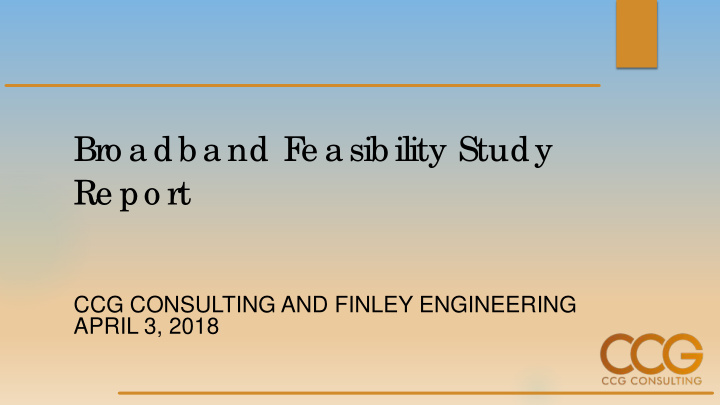



Bro a db a nd F e a sib ility Study Re po rt CCG CONSULTING AND FINLEY ENGINEERING APRIL 3, 2018
Pro je c t Go a l 2 To determine the financial feasibility of constructing a citywide fiber network to provide gigabit-capable broadband throughout the City.
T he F e a sib ility Study 3 Engineering design for citywide fiber. Speed tests / bill analysis. Review of legal issues. Financial business plans. Risks and benefit analysis. Timeline. Written report.
Be ne fits o f Bro a db a nd in Da vis 4 Expand customer choice. Extend University services. Ubiquitous WiFi. Economic development – support hi-tech businesses. Prepare for smart city applications. Digital divide – provide affordable broadband for everybody.
Po te ntia l Risks 5 Comcast expanding capabilities to 1 Gbps downloads. 5G might bring wireless broadband. MDU market already competitive. Likely to see some cherry-picking by ISPs of the ‘best’ neighborhoods. Triple play products (cable and phone) are eroding in market power. Operational risks from entering a highly technical business.
Ne two rk De sig n 6 Build fiber past every resident and business. Includes fiber rings for redundancy. Selected active Ethernet technology capable today of speeds up to 10 Gbps download. Building to apartments is a challenge.
Co st o f the Ne two rk 7 At a 50% customer penetration: Fiber $ 65.9 M Drops $ 10.6 M Customer Electronics $ 7.9 M Other Electronics $ 11.9 M Huts $ 2.2 M Other Assets $ 1.2 M Contingency $ 7.0 M Total $106.7 M
Why the Ne two rk is E xpe nsive 8 100% buried network – poles in Davis are not well-placed for fiber. California rules for prevailing wage adds to cost of construction Density of housing adds to the cost of construction. Municipal bidding rules make it difficult to negotiate a lower cost of construction.
Busine ss Mo de ls Co nside re d 9 Single Provider – the City or one partner is the ISP. Open Access – allows multiple ISPs access to the network. Public / Private Partnership – a private entity would pay for some of the network.
F ina nc ia l Re sults – Sing le Pro vide r 10 Most Conservative Look. With all bond debt of $136 M it loses $54 M over 25 years. Can work with $37 M of other tax financing. Least Conservative Look. Works with $89 M of bond debt and $24 M of other tax revenue. 100% Tax-Financed Look. Could give affordable broadband to every home.
F ina nc ia l Re sults – Ope n Ac c e ss 11 Would allow multiple ISPs onto network. ISPs would pay for some customer electronics. With 100% bond financing of $118 M the project loses $114 M over 25 years. Cannot find a scenario that makes this reasonable. Is a major challenge to attract multiple quality ISPs.
F ina nc ia l Re sults – Pub lic Priva te Pa rtne rship 12 Would include a commercial partner that helps to pay for the network. The City would still have to pay for most of the network. This would still require substantial tax-revenue to make this attractive to a partner. Downside is that private partners would want most or all of the ‘profits’. This would be more feasible if the base business plan was more profitable.
F ina nc ia l Re sults – Se nsitivity F inding s 13 General obligation bonds cheaper than revenue bonds. Costs increases to add more customers. The models are sensitive to interest rates Broadband rate increases help model (but might not be the social goal of the City). Hard to predict MDU (apartment) penetration rates.
K e y F inding s o f the Study 14 Davis has the same kind of broadband as most cities – fast, but relatively expensive. There are a few broadband gaps – low income, downtown businesses. There are major benefits from fiber, but also numerous risks. High cost of construction makes this a challenge. Partnering with one provider looks like the best financial scenario.
K e y F inding s o f the Study (2) 15 Financing fiber will require some funding from tax revenues other than bonds. There are some intriguing scenarios for building fiber to everybody. Open access looks difficult to justify. The apartment market is already competitive and will be a challenge to penetrate.
Re c o mme nde d Ne xt Ste ps 16 Residential survey to understand market demand. MDU (apartment) analysis to understand the market better. Explore the funding options – using some tax revenues. Choose the business model (identify partner). Community education / buy-in.
Re c o mme nde d Ne xt Ste ps (2) 17 Consider the idea of building in phases. In-depth review of City practices that affect fiber costs. Keep an eye on broadband prices – if Comcast raises rates this becomes more feasible.
Co nta c ts 18 Doug Dawson, President, CCG Consulting blackbean2@ccgcomm.com (202) 255-7689 Mark Mrla, Finley Engineering mmrla@finleyusa.com (507) 777-2255
Recommend
More recommend